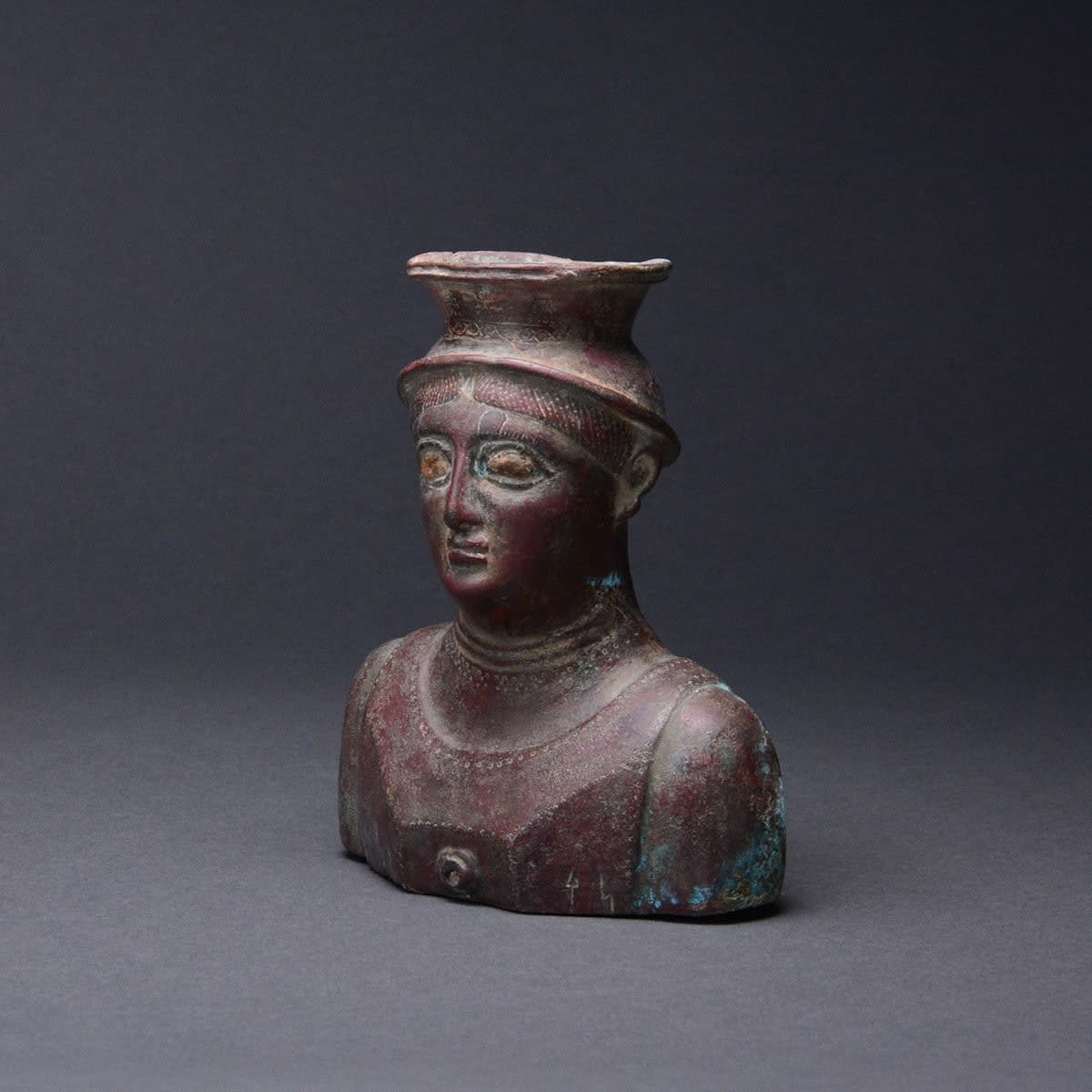Sabean Bronze Bust of a Man, 300 BCE - 100 BCE
Bronze
height 15.6 cm
height 6 1/8 in
height 6 1/8 in
X.0027 (LSO)
Further images
This striking bust is a commemorative piece from the ancient kingdom of Saba which ruled over the lands of southwestern Arabia, centered in modern day Yemen. Technically, the Sabeans were...
This striking bust is a commemorative piece from the ancient kingdom of Saba which ruled over the lands of southwestern Arabia, centered in modern day Yemen. Technically, the Sabeans were one of four major powers in this area, also including the Minaeans, the Qatabanians and the Hadramites, but the peoples as a whole became subsumed as a single entity by the middle of the first millennium BC. Saba is perhaps better known as Sheba, whose famous Queen was recounted as having visited Solomon in the pages of the Old Testament. The wealth of the kingdom is legendary, and is primarily attributable to Saba’s position at the crossroads of the ancient world, receiving consignments (particularly of incense) from all across the Middle East, Asia and the Mediterranean basin. The city of Marib was also in an ideal position to control the trade route between India and Egypt, although this lucrative venture was cut short in the 1st century AD following the foundation of a nautical route from India directly to the port of Alexandria.
As well as being a highly successful nation state in their own right, the Sabeans embraced the multiplicity of cultural influences that came with their status as a trading superpower. Their alphabet – Musnad – was one of the most complex and elegant of the day, while they also had a second, cursive system (Zabur) that was used for day-to-day operations. They mummified their dead, had a pantheon of gods, and possessed liberal attitudes to the deities and traditions of outsiders. They also had a complex social stratification system, extensive public buildings and ceremonial architecture, and a literary/theatrical heritage that survives in fragmented state. It is for their art, however, that the Sabeans are best remembered. Their religion and mythology fuelled the themes of their sculptural works – primarily anthropomorphic and zoomorphic statuary – while their contact with other cultures and nations led to a highly derived and distinctive style. There are major works in bronze, precious metals, exotic minerals and soft stone such as alabaster.
This magnificent hollow-cast bronze bust of a young man is but one example of the luxurious nature of Sabean art. The piece depicts the youth with a rather long face, high cheekbones and what was presumably fashionable apparel. He has large eyes with raised rims and traces of inlay around protruding pupils. His straight nose and brows are shaped into a “T” formation, above finely-chiselled protruding lips and a chin that curves gently into the neck profile. He appears to be wearing a sleeveless garment, judging from the straps passing over the shoulders, but it may in fact be a suit of armour as the frontal aspect is angular and appears to be reinforced (and decorated with small punch-marks). He wears two or three neck rings, and his fashionably coiffed hair is surmounted with a helmet-like piece of headwear with incised grape decoration. The naturalistic rendering of the features betrays a Classical influence that was present all across Western and Central Asia at that time. The expense involved in producing such a piece indicates that the sitter was a person of substance, and was just as socially important as this piece is beautiful.
As well as being a highly successful nation state in their own right, the Sabeans embraced the multiplicity of cultural influences that came with their status as a trading superpower. Their alphabet – Musnad – was one of the most complex and elegant of the day, while they also had a second, cursive system (Zabur) that was used for day-to-day operations. They mummified their dead, had a pantheon of gods, and possessed liberal attitudes to the deities and traditions of outsiders. They also had a complex social stratification system, extensive public buildings and ceremonial architecture, and a literary/theatrical heritage that survives in fragmented state. It is for their art, however, that the Sabeans are best remembered. Their religion and mythology fuelled the themes of their sculptural works – primarily anthropomorphic and zoomorphic statuary – while their contact with other cultures and nations led to a highly derived and distinctive style. There are major works in bronze, precious metals, exotic minerals and soft stone such as alabaster.
This magnificent hollow-cast bronze bust of a young man is but one example of the luxurious nature of Sabean art. The piece depicts the youth with a rather long face, high cheekbones and what was presumably fashionable apparel. He has large eyes with raised rims and traces of inlay around protruding pupils. His straight nose and brows are shaped into a “T” formation, above finely-chiselled protruding lips and a chin that curves gently into the neck profile. He appears to be wearing a sleeveless garment, judging from the straps passing over the shoulders, but it may in fact be a suit of armour as the frontal aspect is angular and appears to be reinforced (and decorated with small punch-marks). He wears two or three neck rings, and his fashionably coiffed hair is surmounted with a helmet-like piece of headwear with incised grape decoration. The naturalistic rendering of the features betrays a Classical influence that was present all across Western and Central Asia at that time. The expense involved in producing such a piece indicates that the sitter was a person of substance, and was just as socially important as this piece is beautiful.







